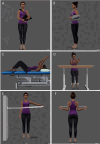The Application of Virtual Reality in Shoulder Surgery Rehabilitation
- PMID: 38752078
- PMCID: PMC11094526
- DOI: 10.7759/cureus.58280
The Application of Virtual Reality in Shoulder Surgery Rehabilitation
Abstract
To achieve a positive functional prognosis in orthopedic surgery, particularly in shoulder surgeries, effective rehabilitation is essential. Recently, there has been growing interest in the use of virtual reality (VR) in the field of orthopedics, particularly for preoperative education and training, as well as clinical and home-based rehabilitation. This report describes the process of developing an application utilizing Meta Quest 2 VR technology (Meta, CA, USA) for rehabilitation after shoulder surgery. This application assists patients in performing postoperative exercises at home by wearing VR equipment tailored to their postoperative weeks. The advantages of VR rehabilitation lie in overcoming the limitations of traditional rehabilitation methods and providing patients with a better rehabilitation experience. Moreover, automating the rehabilitation process and reducing patients' visits to clinics can lead to cost savings. This report raises expectations for the potential and scalability of VR utilization, extending beyond orthopedics to other fields. In addition, it anticipates that with better feedback and motivation, the rehabilitation effects for patients can be further enhanced.
Keywords: mixed reality; oculus quest 2; rehabilitation; shoulder; virtual reality.
Copyright © 2024, Nam et al.
Conflict of interest statement
The authors have declared that no competing interests exist.
Figures
Similar articles
-
Immersive virtual reality for shoulder rehabilitation: evaluation of a physical therapy program executed with oculus quest 2.BMC Musculoskelet Disord. 2023 Nov 2;24(1):859. doi: 10.1186/s12891-023-06861-5. BMC Musculoskelet Disord. 2023. PMID: 37919702 Free PMC article.
-
Virtual reality applied to home-visit rehabilitation for hemiplegic shoulder pain in a stroke patient: a case report.J Rural Med. 2021 Jul;16(3):174-178. doi: 10.2185/jrm.2021-003. Epub 2021 Jul 1. J Rural Med. 2021. PMID: 34239631 Free PMC article.
-
Virtual Reality for Shoulder Rehabilitation: Accuracy Evaluation of Oculus Quest 2.Sensors (Basel). 2022 Jul 23;22(15):5511. doi: 10.3390/s22155511. Sensors (Basel). 2022. PMID: 35898015 Free PMC article.
-
Virtual Reality, Augmented Reality, Gamification, and Telerehabilitation: Psychological Impact on Orthopedic Patients' Rehabilitation.J Clin Med. 2020 Aug 7;9(8):2567. doi: 10.3390/jcm9082567. J Clin Med. 2020. PMID: 32784745 Free PMC article. Review.
-
Is Virtual Reality Effective in Orthopedic Rehabilitation? A Systematic Review and Meta-Analysis.Phys Ther. 2019 Oct 28;99(10):1304-1325. doi: 10.1093/ptj/pzz093. Phys Ther. 2019. PMID: 31343702
Cited by
-
Integrating Artificial Intelligence and Virtual Reality in Orthopedic Surgery: A Comprehensive Review.HSS J. 2025 Jun 17:15563316251345479. doi: 10.1177/15563316251345479. Online ahead of print. HSS J. 2025. PMID: 40546984 Free PMC article. Review.
-
Application of Augmented Reality in Reverse Total Shoulder Arthroplasty: A Systematic Review.J Clin Med. 2025 Aug 6;14(15):5533. doi: 10.3390/jcm14155533. J Clin Med. 2025. PMID: 40807155 Free PMC article. Review.
References
-
- Measuring function of the shoulder. A cross-sectional comparison of five questionnaires. Beaton DE, Richards RR. J Bone Joint Surg Am. 1996;78:882–890. - PubMed
-
- Robotics in shoulder rehabilitation. Sicuri C, Porcellini G, Merolla G. https://www.ncbi.nlm.nih.gov/pmc/articles/PMC4187609/ Muscles Ligaments Tendons J. 2014;4:207–213. - PMC - PubMed
-
- Biomechanical measures of balance after balance-based exergaming training dedicated for patients with Parkinson's disease. Brachman A, Marszałek W, Kamieniarz A, Michalska J, Pawłowski M, Juras G. Gait Posture. 2021;87:170–176. - PubMed
LinkOut - more resources
Full Text Sources


